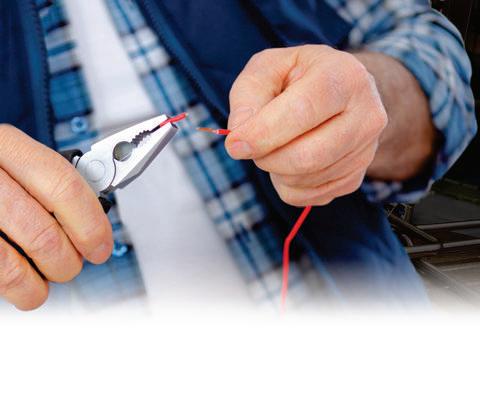
6 minute read
NEWS
Improving Automation’s Energy Efficiency with Neuromorphic Sensor Technology
By David Miller Senior Technical Writer
With its ability to help automate quality control, guide flexible pick-and-place systems, and simplify inventory tracking procedures, machine vision is of growing importance to industrial automation technology. By converting light captured via a smart camera into various types of digital image outputs, machine vision sensors provide a wealth of complex data that can allow automated systems to identify objects, navigate complex and changing workspaces, and analyze materials in a manner that was previously out of reach.
To expand its own machine vision offerings, Zebra Technologies—a company focused on data capture and automatic identification products—has acquired the imaging division of electronic company Matrox. Matrox, which also produces audio-video software and hardware for the broadcast market will retain this division.
Shortly before the acquisition, Zebra established a machine vision business unit with the intention of devoting more resources to its machine vision products. "Through the introduction of more advanced, image-based sensing technologies and softwarebased visual analytics, Zebra can give customers greater visibility into the status of assets at the operational edge of their businesses to…operate more efficiently with increasingly automated, data-powered workflows, " said Donato Montanari, vice president and general manager of machine vision for Zebra.
Until the acquisition is finalized later this year, Montanari said Zebra will focus on tapping the expertise of Matrox’s machine vision engineers to improve future product releases rather than on rebranding Matrox technologies. More specifically, enhancements to Zebra’s automatic identification and data capture technologies, barcode and RFIDbased data capture devices, and indoor location tracking offerings will be achieved by adding more advanced machine vision hardware, software, and services, such as 3D sensing and frame grabbers.
Zebra’s acquisition of Matrox’s imaging division follows its 2021 acquisition of machine vision software provider Adaptive Vision. That acquisition provided Zebra with access to enhanced machine learning and deep learning capabilities, improving the analytics capabilities of the company’s machine vision software. "Zebra’s enterprise asset intelligence vision is for every asset and front-line worker on the edge to be visible, connected, and fully optimized," Montanari said. "Matrox Imaging will position Zebra to provide customers a broader spectrum of information about their assets, above and beyond identification. They will further our ability to enrich complex workflows with greater visibility, enabling the automation of repetitive tasks and answering a wider range of questions related to the inspection of assets such as build quality, consistency, proper quantities, and more."
By David Miller Senior Technical Writer
While the term industrial automation typically refers to machines with the ability to perform highly structured, pre-programmed tasks in place of human labor, the term industrial autonomy describes systems that are capable of adapting independently to diverse circumstances with minimal human intervention. For instance, an autonomous robot might be capable of learning to grip an unfamiliar object or navigate a new space without assistance from a human programmer. Artificial intelligence and machine learning provide the internal processing power necessary to enable this, but powerful external sensors are also needed to help robots and other automated technologies perceive and respond to their environments.
That’s why technologies such as “sensor fusion,” which grants a single sensor the ability to monitor multiple input types, are on the rise. These advanced sensor technologies are made possible by the exponential growth in computing capacity over the past several decades, which allowed more intelligence to be packed into smaller and smaller devices. However, the added processing power comes at a cost— namely, an increase in energy consumption.
To overcome this challenge, FraunhoferGesellshaft, a major European applied research organization, has launched NeurOSmart, a joint research initiative with the Fraunhofer Institute for Photonic Microsystems. The project aims to use neuromorphic electronics, which are modeled on the operations of the human brain, to use less energy. As part of this project, neuromorphic sensors will be installed in robotic systems for use in manufacturing environments with the goal of increasing their energy efficiency.
The data processing performed by neuromorphic sensors is “realized by a novel analog computer memory technology that is also capable of performing computational operations when data is newly acquired in the system,” explained Michael Mensing, a scientist and project leader at the Fraunhofer Institute for Photonic Microsystems. “In practice, this is used to recognize objects and their behavior accurately and in real time. Until now, this mode of operation has required several separately developed components in computers and particularly energy-intensive communication between them.”
According to the Fraunhofer Institute for Photonic Microsystems, this new approach makes use of integrated electronics that allow for the parallel development of models for object recognition and classification that are specially adapted to individual sensors. This allows for a faster response time, increased data protection, and significant energy savings compared to current methods.
The NeurOSmart Initative has a project budget of 8 million Euros and will operate for four years, during which it will attempt to integrate its neuromorphic sensor electronics with a complex light detection and ranging (LiDAR) system.
PACK EXPO International 2022 Preview
By Sean Riley
Senior Director, Media and Industry Communications, PMMI
Registration is now open for the long awaited return of PACK EXPO International 2022 (Oct. 23-26; McCormick Place, Chicago), the most comprehensive packaging and processing show in the world in 2022. In response to the unprecedented demands on the industry, PACK EXPO International 2022 will offer more features than ever before, according to show producer PMMI, The Association for Packaging and Processing Technologies.
PACK EXPO International 2022 will showcase packaging-related devices, machinery, and software for more than 40 vertical markets. No other event this year will feature entire production line solutions and offer attendees everything needed to compete in a changing marketplace.
“There has been so much innovation in our industry that end users can’t afford to miss this opportunity to see the latest breakthroughs,” says Jim Pittas, president and CEO, PMMI.
New PACK EXPO features
The interactive PACK to the Future exhibit celebrates the role of packaging and processing through history and the impact it is poised to have on our future. The PACK to the Futurestage will provide free industry-expert presentations on cutting-edge advancements.
PACK Match at PACK EXPO International debuts, providing attendees complimentary personalized, one-on-one guidance with PACK Match Advisors to connect attendees with the right suppliers.
The Emerging Brands Summit will launch at PACK EXPO International 2022 and will be a one-day event featuring educational content, tabletop exhibits and expert advisors. This new program is aimed at founders and leaders of startup manufacturing companies looking to scale their brand to larger production through facility build outs or outsourced relationships with contract manufacturers and packagers.
PACK Challenge is a brand-new packaging competition that brings high school teams together for a head-to-head machine-building competition. The winning school will be awarded $5,000 with an additional $2,000 split between individual team members. Afterward, the teams will take the machines back to their school, providing future students the opportunity for hands-on experience.
The Processing Zone returns to PACK EXPO International in 2022 along with the Processing Innovation Stage focusing on the latest breakthroughs in processing. In today’s manufacturing environment, processing and packaging are integrated systems, making it critical to bring both operations under one roof.
The new Industry Speaks Stage features expert sessions from the PACK EXPO Partner Program, addressing the latest hot button topics and industry trends across multiple industry verticals.
To learn more and register, visit packexpointernational.com. Registration for the show is $30 until Sept. 30, after which it increases to $130.
Wireless Limit Switches cut out more than just wires...
They eliminate batteries. They eliminate regular
maintenance. And, most importantly, they
reduce cost; at the time of installation
and throughout the life of the switch.
The best part? They do all this while
maintaining the reliability of cable-
XCMW Wireless & Battery-less Limit Switch:
The energy from the actuator movement converts into the power necessary to send a wireless signal. connected switches. See the FREE


white paper at the link below and
cut the Limit Switch wires for good!







